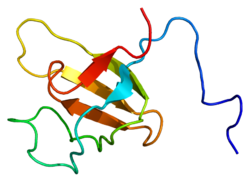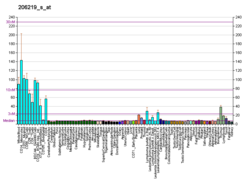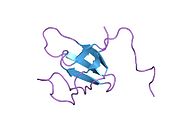VAV1
Proto-oncogene vav is a protein that in humans is encoded by the VAV1 gene.[5]
Function
The protein encoded by this proto-oncogene is a member of the Dbl family of guanine nucleotide exchange factors (GEF) for the Rho family of GTP binding proteins. The protein is important in hematopoiesis, playing a role in T-cell and B-cell development and activation. This particular GEF has been identified as the specific binding partner of Nef proteins from HIV-1. Coexpression and binding of these partners initiates profound morphological changes, cytoskeletal rearrangements and the JNK/SAPK signaling cascade, leading to increased levels of viral transcription and replication.[6]
Interactions
VAV1 has been shown to interact with:
References
- ^ a b c GRCh38: Ensembl release 89: ENSG00000141968 – Ensembl, May 2017
- ^ a b c GRCm38: Ensembl release 89: ENSMUSG00000034116 – Ensembl, May 2017
- ^ "Human PubMed Reference:". National Center for Biotechnology Information, U.S. National Library of Medicine.
- ^ "Mouse PubMed Reference:". National Center for Biotechnology Information, U.S. National Library of Medicine.
- ^ Han J, Luby-Phelps K, Das B, Shu X, Xia Y, Mosteller RD, Krishna UM, Falck JR, White MA, Broek D (February 1998). "Role of substrates and products of PI 3-kinase in regulating activation of Rac-related guanosine triphosphatases by Vav". Science. 279 (5350): 558–60. Bibcode:1998Sci...279..558H. doi:10.1126/science.279.5350.558. PMID 9438848.
- ^ "Entrez Gene: VAV1 vav 1 oncogene".
- ^ Groysman M, Russek CS, Katzav S (February 2000). "Vav, a GDP/GTP nucleotide exchange factor, interacts with GDIs, proteins that inhibit GDP/GTP dissociation". FEBS Lett. 467 (1): 75–80. doi:10.1016/S0014-5793(00)01121-2. PMID 10664460. S2CID 40103095.
- ^ Bassermann F, Jahn T, Miething C, Seipel P, Bai RY, Coutinho S, Tybulewicz VL, Peschel C, Duyster J (April 2002). "Association of Bcr-Abl with the proto-oncogene Vav is implicated in activation of the Rac-1 pathway". J. Biol. Chem. 277 (14): 12437–45. doi:10.1074/jbc.M112397200. PMID 11790798.
- ^ a b Bertagnolo V, Marchisio M, Brugnoli F, Bavelloni A, Boccafogli L, Colamussi ML, Capitani S (April 2001). "Requirement of tyrosine-phosphorylated Vav for morphological differentiation of all-trans-retinoic acid-treated HL-60 cells". Cell Growth Differ. 12 (4): 193–200. PMID 11331248.
- ^ Marengère LE, Mirtsos C, Kozieradzki I, Veillette A, Mak TW, Penninger JM (July 1997). "Proto-oncoprotein Vav interacts with c-Cbl in activated thymocytes and peripheral T cells". J. Immunol. 159 (1): 70–6. doi:10.4049/jimmunol.159.1.70. PMID 9200440.
- ^ Hobert O, Jallal B, Ullrich A (June 1996). "Interaction of Vav with ENX-1, a putative transcriptional regulator of homeobox gene expression". Mol. Cell. Biol. 16 (6): 3066–73. doi:10.1128/MCB.16.6.3066. PMC 231301. PMID 8649418.
- ^ a b Germani A, Romero F, Houlard M, Camonis J, Gisselbrecht S, Fischer S, Varin-Blank N (May 1999). "hSiah2 is a new Vav binding protein which inhibits Vav-mediated signaling pathways". Mol. Cell. Biol. 19 (5): 3798–807. doi:10.1128/MCB.19.5.3798. PMC 84217. PMID 10207103.
- ^ a b c Song JS, Gomez J, Stancato LF, Rivera J (October 1996). "Association of a p95 Vav-containing signaling complex with the FcepsilonRI gamma chain in the RBL-2H3 mast cell line. Evidence for a constitutive in vivo association of Vav with Grb2, Raf-1, and ERK2 in an active complex". J. Biol. Chem. 271 (43): 26962–70. doi:10.1074/jbc.271.43.26962. PMID 8900182.
- ^ Ye ZS, Baltimore D (Dec 1994). "Binding of Vav to Grb2 through dimerization of Src homology 3 domains". Proc. Natl. Acad. Sci. U.S.A. 91 (26): 12629–33. Bibcode:1994PNAS...9112629Y. doi:10.1073/pnas.91.26.12629. PMC 45492. PMID 7809090.
- ^ a b Lee IS, Liu Y, Narazaki M, Hibi M, Kishimoto T, Taga T (January 1997). "Vav is associated with signal transducing molecules gp130, Grb2 and Erk2, and is tyrosine phosphorylated in response to interleukin-6". FEBS Lett. 401 (2–3): 133–7. doi:10.1016/s0014-5793(96)01456-1. PMID 9013873. S2CID 32632406.
- ^ a b Shigematsu H, Iwasaki H, Otsuka T, Ohno Y, Arima F, Niho Y (May 1997). "Role of the vav proto-oncogene product (Vav) in erythropoietin-mediated cell proliferation and phosphatidylinositol 3-kinase activity". J. Biol. Chem. 272 (22): 14334–40. doi:10.1074/jbc.272.22.14334. PMID 9162069.
- ^ Matsuguchi T, Inhorn RC, Carlesso N, Xu G, Druker B, Griffin JD (January 1995). "Tyrosine phosphorylation of p95Vav in myeloid cells is regulated by GM-CSF, IL-3 and steel factor and is constitutively increased by p210BCR/ABL". EMBO J. 14 (2): 257–65. doi:10.1002/j.1460-2075.1995.tb06999.x. PMC 398079. PMID 7530656.
- ^ Romero F, Dargemont C, Pozo F, Reeves WH, Camonis J, Gisselbrecht S, Fischer S (January 1996). "p95vav associates with the nuclear protein Ku-70". Mol. Cell. Biol. 16 (1): 37–44. doi:10.1128/mcb.16.1.37. PMC 230976. PMID 8524317.
- ^ Paz PE, Wang S, Clarke H, Lu X, Stokoe D, Abo A (June 2001). "Mapping the Zap-70 phosphorylation sites on LAT (linker for activation of T cells) required for recruitment and activation of signalling proteins in T cells". Biochem. J. 356 (Pt 2): 461–71. doi:10.1042/0264-6021:3560461. PMC 1221857. PMID 11368773.
- ^ Perez-Villar JJ, Whitney GS, Sitnick MT, Dunn RJ, Venkatesan S, O'Day K, Schieven GL, Lin TA, Kanner SB (August 2002). "Phosphorylation of the linker for activation of T-cells by Itk promotes recruitment of Vav". Biochemistry. 41 (34): 10732–40. doi:10.1021/bi025554o. PMID 12186560.
- ^ Raab M, da Silva AJ, Findell PR, Rudd CE (February 1997). "Regulation of Vav-SLP-76 binding by ZAP-70 and its relevance to TCR zeta/CD3 induction of interleukin-2". Immunity. 6 (2): 155–64. doi:10.1016/s1074-7613(00)80422-7. PMID 9047237.
- ^ Onodera H, Motto DG, Koretzky GA, Rothstein DM (September 1996). "Differential regulation of activation-induced tyrosine phosphorylation and recruitment of SLP-76 to Vav by distinct isoforms of the CD45 protein-tyrosine phosphatase". J. Biol. Chem. 271 (36): 22225–30. doi:10.1074/jbc.271.36.22225. PMID 8703037.
- ^ a b Bertagnolo V, Marchisio M, Volinia S, Caramelli E, Capitani S (Dec 1998). "Nuclear association of tyrosine-phosphorylated Vav to phospholipase C-gamma1 and phosphoinositide 3-kinase during granulocytic differentiation of HL-60 cells". FEBS Lett. 441 (3): 480–4. doi:10.1016/s0014-5793(98)01593-2. PMID 9891995. S2CID 38371954.
- ^ Hehner SP, Li-Weber M, Giaisi M, Dröge W, Krammer PH, Schmitz ML (April 2000). "Vav synergizes with protein kinase C theta to mediate IL-4 gene expression in response to CD28 costimulation in T cells". J. Immunol. 164 (7): 3829–36. doi:10.4049/jimmunol.164.7.3829. PMID 10725744.
- ^ Fackler OT, Luo W, Geyer M, Alberts AS, Peterlin BM (June 1999). "Activation of Vav by Nef induces cytoskeletal rearrangements and downstream effector functions". Mol. Cell. 3 (6): 729–39. doi:10.1016/S1097-2765(01)80005-8. PMID 10394361.
- ^ Lindholm CK, Henriksson ML, Hallberg B, Welsh M (July 2002). "Shb links SLP-76 and Vav with the CD3 complex in Jurkat T cells". Eur. J. Biochem. 269 (13): 3279–88. doi:10.1046/j.1432-1033.2002.03008.x. PMID 12084069.
- ^ Deckert M, Tartare-Deckert S, Couture C, Mustelin T, Altman A (Dec 1996). "Functional and physical interactions of Syk family kinases with the Vav proto-oncogene product". Immunity. 5 (6): 591–604. doi:10.1016/s1074-7613(00)80273-3. PMID 8986718.
Further reading
- Romero F, Fischer S (1997). "Structure and function of vav". Cell. Signal. 8 (8): 545–53. doi:10.1016/S0898-6568(96)00118-0. PMID 9115846.
- Bustelo XR (2000). "Regulatory and Signaling Properties of the Vav Family". Mol. Cell. Biol. 20 (5): 1461–77. doi:10.1128/MCB.20.5.1461-1477.2000. PMC 85310. PMID 10669724.
- Geyer M, Fackler OT, Peterlin BM (2001). "Structure–function relationships in HIV-1 Nef". EMBO Rep. 2 (7): 580–5. doi:10.1093/embo-reports/kve141. PMC 1083955. PMID 11463741.
- Greenway AL, Holloway G, McPhee DA, Ellis P, Cornall A, Lidman M (2004). "HIV-1 Nef control of cell signalling molecules: multiple strategies to promote virus replication". J. Biosci. 28 (3): 323–35. doi:10.1007/BF02970151. PMID 12734410. S2CID 33749514.
- Anderson JL, Hope TJ (2005). "HIV accessory proteins and surviving the host cell". Current HIV/AIDS Reports. 1 (1): 47–53. doi:10.1007/s11904-004-0007-x. PMID 16091223. S2CID 34731265.
- Stove V, Verhasselt B (2006). "Modelling thymic HIV-1 Nef effects". Curr. HIV Res. 4 (1): 57–64. doi:10.2174/157016206775197583. PMID 16454711.
- Katzav S (2007). "Flesh and blood: the story of Vav1, a gene that signals in hematopoietic cells but can be transforming in human malignancies". Cancer Lett. 255 (2): 241–54. doi:10.1016/j.canlet.2007.04.015. PMID 17590270.
- Bustelo XR, Barbacid M (1992). "Tyrosine phosphorylation of the vav proto-oncogene product in activated B cells". Science. 256 (5060): 1196–9. Bibcode:1992Sci...256.1196B. doi:10.1126/science.256.5060.1196. PMID 1375396. S2CID 35071104.
- Adams JM, Houston H, Allen J, Lints T, Harvey R (1992). "The hematopoietically expressed vav proto-oncogene shares homology with the dbl GDP-GTP exchange factor, the bcr gene and a yeast gene (CDC24) involved in cytoskeletal organization". Oncogene. 7 (4): 611–8. PMID 1565462.
- Katzav S, Cleveland JL, Heslop HE, Pulido D (1991). "Loss of the amino-terminal helix-loop-helix domain of the vav proto-oncogene activates its transforming potential". Mol. Cell. Biol. 11 (4): 1912–20. doi:10.1128/MCB.11.4.1912. PMC 359873. PMID 2005887.
- Coppola J, Bryant S, Koda T, Conway D, Barbacid M (1991). "Mechanism of activation of the vav protooncogene". Cell Growth Differ. 2 (2): 95–105. PMID 2069873.
- Katzav S, Martin-Zanca D, Barbacid M (1989). "vav, a novel human oncogene derived from a locus ubiquitously expressed in hematopoietic cells". EMBO J. 8 (8): 2283–90. doi:10.1002/j.1460-2075.1989.tb08354.x. PMC 401160. PMID 2477241.
- Ramos-Morales F, Romero F, Schweighoffer F, Bismuth G, Camonis J, Tortolero M, Fischer S (1995). "The proline-rich region of Vav binds to Grb2 and Grb3-3". Oncogene. 11 (8): 1665–9. PMID 7478592.
- Weng WK, Jarvis L, LeBien TW (1995). "Signaling through CD19 activates Vav/mitogen-activated protein kinase pathway and induces formation of a CD19/Vav/phosphatidylinositol 3-kinase complex in human B cell precursors". J. Biol. Chem. 269 (51): 32514–21. doi:10.1016/S0021-9258(18)31664-8. PMID 7528218.
- Matsuguchi T, Inhorn RC, Carlesso N, Xu G, Druker B, Griffin JD (1995). "Tyrosine phosphorylation of p95Vav in myeloid cells is regulated by GM-CSF, IL-3 and steel factor and is constitutively increased by p210BCR/ABL". EMBO J. 14 (2): 257–65. doi:10.1002/j.1460-2075.1995.tb06999.x. PMC 398079. PMID 7530656.
- Uddin S, Katzav S, White MF, Platanias LC (1995). "Insulin-dependent tyrosine phosphorylation of the vav protooncogene product in cells of hematopoietic origin". J. Biol. Chem. 270 (13): 7712–6. doi:10.1074/jbc.270.13.7712. PMID 7535775.
- Machide M, Mano H, Todokoro K (1995). "Interleukin 3 and erythropoietin induce association of Vav with Tec kinase through Tec homology domain". Oncogene. 11 (4): 619–25. PMID 7651724.
- Clevenger CV, Ngo W, Sokol DL, Luger SM, Gewirtz AM (1995). "Vav is necessary for prolactin-stimulated proliferation and is translocated into the nucleus of a T-cell line". J. Biol. Chem. 270 (22): 13246–53. doi:10.1074/jbc.270.22.13246. PMID 7768923.
- Katzav S, Sutherland M, Packham G, Yi T, Weiss A (1995). "The protein tyrosine kinase ZAP-70 can associate with the SH2 domain of proto-Vav". J. Biol. Chem. 269 (51): 32579–85. doi:10.1016/S0021-9258(18)31673-9. PMID 7798261.
- Ye ZS, Baltimore D (1995). "Binding of Vav to Grb2 through dimerization of Src homology 3 domains". Proc. Natl. Acad. Sci. U.S.A. 91 (26): 12629–33. Bibcode:1994PNAS...9112629Y. doi:10.1073/pnas.91.26.12629. PMC 45492. PMID 7809090.







